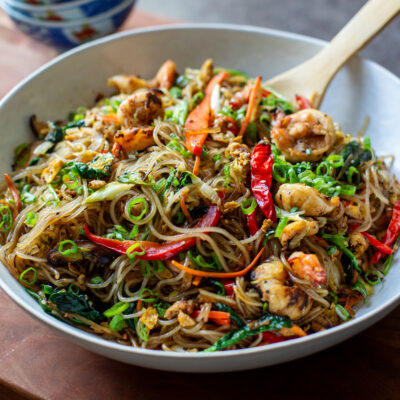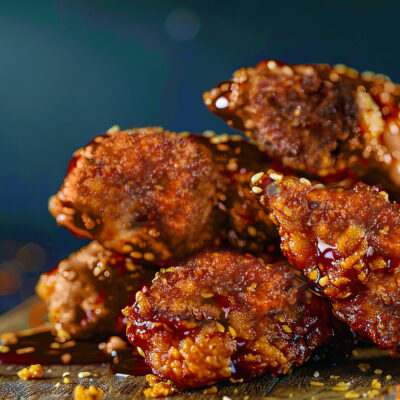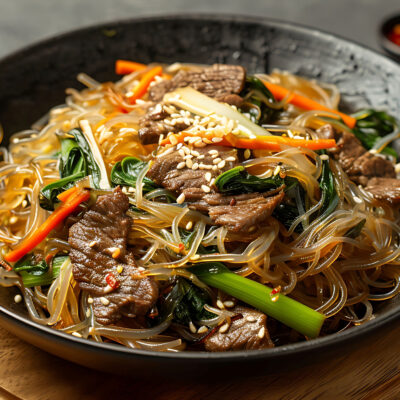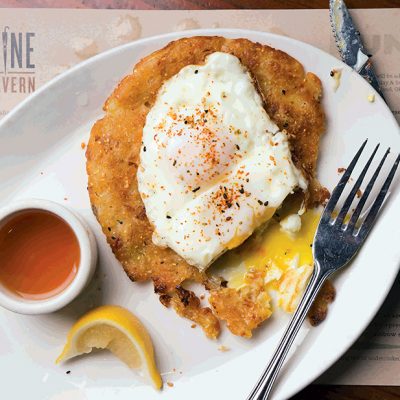Cold Korean Noodle Soup
Korean mul naengmyun (also called mul naengmyeon) has it all—it’s tart and earthy, beefy and cold, all on a field of chewy noodles and slushy broth studded with green onion and pickled radish. Naengmyun means “cold noodles” in English, and refers to chilled Korean dishes made of long, thin noodles. Mul-naengmyun, is served in an icy cold slushy broth made from beef, chicken or dongchimi. I add a healthy dollop of a robust homemade chili paste to the classic recipe to create my favorite version, bibim mul naengmyun. Naengmyun noodles are extremely tricky to make from scratch and are traditionally made from buckwheat, sweet potato, potato, arrowroot, kudzu and a whole variety of starches. Lucky for all of us, Korean markets sell pre-portioned dried naengmyun noodles. They cook quickly, too.
Culinary Literacy, Korea: Iced Noodles with Chiles & Poached Beef
Ingredients
- 2 quarts homemade chicken stock (this is crucial because the store-bought stuff doesn’t have enough collagen and gelatin in it for this recipe’s technique)
- 4 scallions, minced or sliced thin on an angle
- 1 large shallot, sliced thin
- 8 shiitake mushrooms, chopped
- 1 piece of dried kelp (Kombu) about 3 inches square
- 1 piece ginger, roughly the size of a golf ball, sliced
- 6 cloves garlic, peeled
- 1 pound block chunk of brisket, I like the fatty end but that’s just me. I slice mine very thin by hand, but you can always ask your butcher to slice it thin on his slicer.
- 8-12 ounces Korean pickled radish (pickling brine reserved)
- 4 portions of Korean naengmyun noodles
- Cucumber, julienned
- Shiso leaf, julienne
- Asian pear, julienne
- 1/2 cup of rice wine vinegar
- 1/4 cup sugar
- Chile Sauce (bibim) recipe below
Chile Sauce
- 2 tablespoons sesame oil
- 2 ounces of chopped shallot, roughly 2 or 3 golfball sized ones
- 3 tablespoons kochujang (red pepper paste) also called gochujang
- 2 tablespoon vinegar
- 2 tablespoons sugar
- 2 tablespoons sesame seeds
- 1/4 cup Korean red pepper powder
- 1/2 teaspoon salt
- 1 clove garlic, roughly chopped
- About 1/2 cup cold beef or chicken broth
Instructions
SERVINGS: 4
First, Make the Chile Sauce (bibim)
Puree all ingredients in a blender and refrigerate overnight.
Poach the Brisket
Place the chicken broth, scallion, shallot, mushrooms, kelp, ginger and garlic cloves in a pot and simmer, with a lid on for 30 minutes. Lift lid and poach the brisket a few slices at a time for about 45 seconds. When all the meat is done cooking, place in a bowl with a few tablespoons of the liquid, and wrap/refrigerate.
Prepare the Broth
Strain the broth through fine mesh. Season with salt and some of the sweet/tart pickle brine if you care to. This dish has a broth with a sweet and sour flavor component so a little of that pickle brine is ideal. You will have more ‘brine’ at the table in the form of the rice wine vinegar/sugar mixture, but Koreans always drizzle a little pickle brine in the hot broth. Refrigerate for 5 hours or overnight if you need to. Remove any fat from top of broth. Place broth in 2 plastic quart containers and place in fridge. Four hours before you want to eat, place the containers in the freezer.
To Serve
Cook noodles in a large volume of boiling salted water for a minute or two until tender, but chewy. Drain and rinse well under cold water until noodles are cold. Gently squeeze them in a paper towel and divide into soup bowls. Take broth from freezer and using a fork mash it up. It should be perfectly shale-y and almost slushy. If you need to pulse it in the microwave because it’s frozen too much, do it very carefully. If it’s frozen solid no worries, use the auto defrost mode…just check it every few minutes.
Portion the slushy broth around the noodles, garnish with sliced egg, sliced radish, julienne cucumber, julienne Asian pear, slices of the brisket and minced scallion. Add a dollop of the chili sauce (Bibim) and serve immediately.
Mix the rice wine vinegar and sugar together, until dissolved. Have the vinegar/sugar mixture on the table for those who want more.
Tip: I always have a pair of sharp scissors at the table to cut anyone’s noodles. These Naengmyun can be very sticky and everyone loves to eat this dish stirred up a little so cutting the noodles helps the novice noodle eater.







